Submersible Heaters
Use of Submersible Water Heaters at MBL
Lisa Abbo, Director Marine Research Services
labbo@mbl.edu
Eric Jensen, MBL Environmental Health and Safety Manager
ejensen@mbl.edu
1. Introduction
Submersible water heaters are commonly used in the aquarium industry to maintain a consistent target water temperature in aquaria.Submersible heaters are also used at the MBL, primarily in stand-alone aquaria but also in semi-recirculating systems where precise temperature control is a requirement.Using water heaters safely requires careful planning and considerations during use. This document reviews these risks and provide both requirements and recommendations on how to configure submersible water heaters safely.
2. Common Heater Types
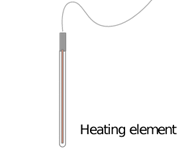
Immersion heaters are generally affixed to the side of a tank with a controller portion that remains above the water surface.Housings are typically made of glass. These types of heaters are generally for the beginner aquarium hobbyists, and many have components that are not fully sealed and unsuitable for marine applications.
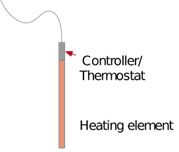
Integrated submersible water heaters have either a single temperature setpoint or a submersible and adjustable temperature control dial on the upper housing.Quality housings for seawater use are made of stainless steel or titanium instead of glass.
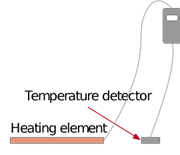
Externally controlled systems use a temperature controller unit for the submersible heater on the exterior of the tank.Temperature is set in the controller and monitored via a submerged temperature probe that is linked to the controller.When the temperature falls below the set point the controller provides power to the heating element.
3. Risks Associated with Submersible Heaters
Submersible aquarium heaters are electrical devices which operate in wet, typically saline environments.This combination of water and electricity presents safety risks to individuals, infrastructure and the housed organisms.Knowledge of these risks and measures to address them are key to prevention.These risks include: electric shock due to exposure of electrical elements to water, loss of specimens due to heater failure, and fire or explosion due to dry operation.
Electric Shock
Operation of high-powered electrical equipment in wet, saline environments is inherently dangerous as saltwater is both electrically conductive and highly corrosive.Salt sprays and aerosols destroy metals, including circuit boards and electrical terminals deep within housings and seemingly sealed units.Risk of serious shock is mitigated through the installation of Ground Fault Circuit Interrupters (GFCI) in tank rooms. In addition, wiring should be routinely inspected against cracking or fraying. If discovered, the unit should immediately be taken out of service.
Heater Failure
All electronic units are susceptible to failure whether via manufacture defect, internal corrosion or electrical current supply.These events, if not noticed promptly can result in loss of specimens.Systems should be monitored on a daily basis to confirm temperatures are within acceptable ranges.Separate electronic monitoring systems to alert of conditions outside of range are highly recommended.
Dry Operation
Submersible seawater heaters generate enormous amounts of heat in order to raise the temperature of seawater.Exposing a hot heater element to the air can cause a catastrophic rise in temperature.This can occur not only when the heater is operating, but up to 30 minutes after power has been turned off. Some heaters are advertised to have auto-shutoff features that cut power to the device when the temperature rises. Unfortunately, it has been shown that this auto-shutoff feature is not dependable once the heater is exposed to air. Additional fail safes are required for all heaters.Overheating creates a risk of fire, burns, explosive bursting of the heater and other dangers.The two common scenarios for dry operation are during system maintenance and inadvertent loss of water volume.
Dry operation can occur during maintenance when a tank is drained for cleaning, or a heater is removed from a tank before being turned off and/or allowed to cool for a sufficient amount of time.This scenario usually occurs due to the immediate actions of a person who can correct the situation from becoming more severe.
Inadvertent loss of volume is the most dangerous condition where a container loses water sufficient to expose the heater element and subsequently causes an overheating condition.This case is more serious because of the likelihood of this occurring without individuals noticing.For MBL purposes, water containers fall into three categories where such a risk can occur as described below.
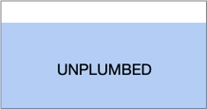
A hobbyist aquarium is an example of an unplumbed container.It has no openings below the normal surface line where water can escape.Aside from evaporation and aerosolization, an unplumbed container under normal operation will not lose water volume.
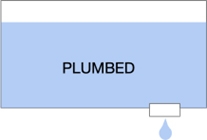
MBL sea tables are an example of a plumbed container.Plumbed systems have a drain located at the base (most common) or an opening in the side.Usually, these openings have a fitting to which to attach additional plumbing, such as a standpipe which extends to the water line.If plumbing is not tight, a leak can occur which can result in draining the container.
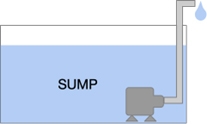
A sump is a container (plumbed or unplumbed) that contains a pump that discharges water out of the container. Typically, these systems discharge to another tank with a drain that returns water to the sump, creating a loop.If the loop is broken, such as the return line being directed away from the sump, the container will lose volume and potentially empty.
4. Mitigating Risk
To protect individuals, specimens and infrastructure from an issue arising from a malfunctioned water heater unit, it is critical that all those involved with the tank setups, maintenance and system checks are all understanding of both potential hazards and required configurations for water heaters.
Potential Hazards
The following lists of actions or requirements, should all be understood by users of submersible water heaters.
1) Do not use heaters enclosed in a glass housing.
Glass can shatter during rapid temperature changes, sometimes explosively.Small aquarium kits often include cheap glass-enclosed heaters which are not designed for professional systems. Glass bodied heaters are not approved for use at MBL
2) Never remove heater from water unless powered OFF for at least 30 minutes.
Removing a hot heater from the water may cause rapid overheating.In extreme cases, a “runaway” heater can explode.Heaters must be turned off 30 minutes prior to removing to allow sufficient time for cooling.
3) If an overheating heater is observed, DO NOT return to water.
A natural instinct is to return an overheating heater to the water in order to cool, but this is extremely dangerous.The rapid temperature change will cause a shattering or cracking of the housing, creating the risk of electric shock, injury from broken pieces or burns.Instead, ensure the heater is unplugged and, while holding it by the cord, gently move unit to a hard non-flammable or melt-able surface (tile, stone, ground) to allow the unit to cool slowly.It should not be used again until inspected and cleared for use by a qualified technician.
4) Ensure heaters and other equipment are intended for use in marine environments.
Equipment intended for freshwater-use-only are often less expensive and may appear appropriate for use.Avoid this mistake.They will not last as long and may expose you or others to danger.Marine systems require sealed electronics and special materials to avoid rapid corrosion and breakage. An approved list of equipment is in Section 6. Using alternative equipment must be approved by MRC Manager or MBL Safety prior to use.>
5) Monitor and remove salt buildup from all equipment components.
Salt sprays and aerosols will coat equipment with corrosive brine that eventually forms a visible salt buildup.These brines can cause electrical failures that present shock hazards.Clean controllers and wiring regularly.
6) Heaters are not permitted in shallow sea tables (6 inch depth or less).
Heaters cannot be placed in shallow sea tables under any circumstances.If heated seawater is required in a shallow sea table, a heater should be set up in a sump below the shallow sea table and pumped up to the table.The shallow sea table will return water to the sump completing the loop.
7) Remove all equipment from a system before it is drained.
For any system maintenance, disinfection, or draining when the intention is to drain the system, all equipment contained in the system must be unplugged and physically removed from the system. No equipment should be left in the system even if it is unplugged.
8) All aquatic systems must be equipped with a secondary alert system such as a water level sensor or temperature sensor.
Either a temperature sensor or a water level sensor must be in place in any aquatic system so that one of two things happens if a system inadvertently drains: 1. an alert is automatically sent to a designated lab person who is equipped to respond to the equipment failure as soon as possible. 2. the sensor is connected to the submersible heater which automatically shuts off the heater.
All sensor systems must be reviewed and approved for use by MRC Manager or MBL Safety.
9) All personnel working with submersible heaters must be trained on their proper use.
All PIs on the MBL campus are responsible for training their staff on the safe use of submersible heaters specific to their systems.All lab personnel must sign off that they have read, understand and will comply with this document.Each laboratory should keep a hardcopy with an attestation sheet in a binder within their laboratory. For any visiting scientists such as Whitman Fellows, Whitman Scientists, Grass Fellow, Course managers, or Workshop facilitators, a staff member from the Marine Resources Center or the Safety Department will train the responsible personnel.
10) Heaters in a deep-sea table must have a fail-safe (typically 16 inch depth).
Heaters can be placed in a deep-sea table that is configured with at least ONE of the Bottom Drain solutions.It is strongly recommended to have both a shut-off features and an external standpipe for a deep-sea table or alternatively use of a sump.See Configuration Requirements (below).
System Configuration Requirements
Unplumbed Containers
Unplumbed containers will not normally run dry unless spilled or ruptured.Such an occurrence usually happens with a person present.In such cases, first action should be to cut power to any and all electrical components of the affected system.Likewise, if a submerged water heater is observed to be malfunctioning (temperature spikes, or significant corrosion) always unplug unit before attempting to remove from container.
Plumbed Containers
Plumbed containers have openings below the operating water level and present a risk, however small, of leaking and potentially exposing a heater to the air.
1) Side Drains
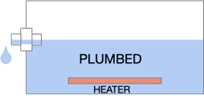
A container may have a fitting in the side of the container where water exits to a drain or water treatment system.Such openings are often fitted with sealed bulkhead fittings that support the installation of pipes and strengthen the opening.
DRAIN HEIGHT: Water heaters must be positioned below the level of the drain.Should the water supply be interrupted the water level cannot drop below the level of the opening.Vertically-mounted heaters should be avoided.
2) Bottom Drains
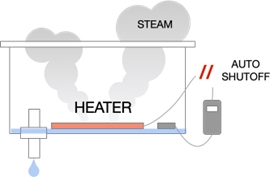
A leaking fitting in a plumbed container with a bottom drain can drain the entire volume of water and expose the heater to the air.MBL sea tables fall into this category.These systems require a failsafe to minimize risk of an overheating water heater. Each system must employ one of the following (preferable two): a temperature control feature, an external shut-off feature (such as a float switch) and/or a secure standpipe assembly.
TEMPERATURE CONTROL:An auto-shutoff feature is the best mechanism for preventing a fire in a drained container.These units, upon exposure to air, detect the rise in temperature above normal operating temperatures and automatically shut down.This threshold temperature may produce steam but will not reach temperatures sufficient to start a fire.
EXTERNAL SHUTOFF: Using an external shutoff feature such as a float switch will kill the power if the water level falls below a threshold level.These are common features in turnkey standalone systems such as used in the MBL zebrafish facility or National Xenopus Resource.Use of a water level sensor may be used, but unless configured to kill the electrical power to the heater these typically will just provide an alert (loud noise).
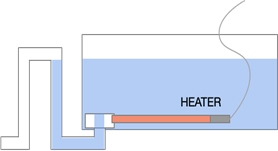
STANDPIPE: Friction-fit internal standpipes have a tendency to leak and are not allowed in tanks with heaters.If used, ensure a tight fit and visually observe that the system doesn’t leak. An external standpipe with a threaded fitting is the prefered setup.This assembly provides a relatively secure connection system for preventing loss of water volume.Thread sealant tape can be applied at fittings for added resistance to leaks.Visual access to the fitting below the tank is required to verify it is secure and not leaking.
3) Sump
A sump contains a pump that discharges water out of the container.If the water is not returned to the container it can be pumped dry, exposing a heater to the air.A sump may be plumbed or unplumbed.The mitigation procedures described above apply to plumbed sumps with the addition of the considerations below.
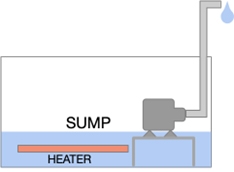
ELEVATE: The sump pump must be elevated such that the water intake remains at a level above the submerged heater.In the event of an unintended pump-out, the suction will break and leave a volume of water covering the heater and prevent an overheating situation.
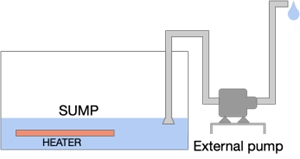
ELEVATE INTAKE: For an external pump, ensure that the plumbed intake is located at a level above the submerged heater.If water pumps out to this level, the pump will lose suction and prevent heater from being exposed to potential overheating.
5. System Checks and Maintenance
With the use of an appropriate water heater and utilizing the correct combination of system configurations an aquatic tank can be managed safely with minimal risks.
All users should be following a checklist for their systems that entails at a minimum a weekly review (preferably daily).This review should not only verify the water heating system and water level are in compliance, but also include specimen health, water quality, tank cleanliness, equipment maintenance, electrical hazards and general area upkeep.
6. Approved Equipment
All new submersible heaters must be the following brand and model. For all other requests, prior approval by the MBL Safety Officer is required. Each system is also required to have a temperature or water level sensor installed.
a. Heater:
b. Heater Controller (to pair with Finnex heater):
c. Temperature Sensor:
d. Optic level Sensor:
- AutoAqua Smart Level Security
- Apex Optial Level Sensor (pairs with Neptune Apex)
- Hydros Water Level Sensor

7. Other Equipment Hazards
Although submersible heaters are viewed as potentially causing the greatest fire concern, other commonly used equipment must be carefully set up and maintained. These include: Ultraviolet lights, water and air pumps and tank lighting.
Ultraviolet Lights
Ultraviolet lights can cause serious damage to the eyes or burns to the skin if not properly handled or maintained. For maintenance, UV lights should be replaced annually. When changing the bulb, the unit must be unplugged and allowed to cool several minutes before swapping out bulbs. Never look into the sleeve when light is on as exposure can damage the eye.
Water and Air Pumps
Water pumps should always have water flow. In the event of a pump going dry, there is the potential for both overheating of the unit and part damage to the unit.
Tank Lighting
All tank lighting must be properly secured as for light to not fall into the tank with a potential electrical hazard. It is recommended to use LED lights for systems.